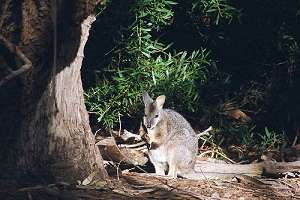The lack of genetic diversity on Garden Island was likely caused by its relative size and length of isolation compared with the bigger Kangaroo Island. Credit: David Clarke
A national genome study into island populations of the tammar wallaby has revealed a startling level of genetic similarity between males on Garden Island.
The study analysed sex-linked microsatellite markers to better understand the species' (Macropus eugenii) genetic diversity on the X and Y sex chromosomes.
Samples were taken from 100 wallabies on both Garden Island in Western Australia and Kangaroo Island in South Australia in order to compare the differences between the two isolated populations.
University of Canberra researcher Dr Anna Macdonald says the emerging availability of sex-linked microsatellite markers has provided new gender-specific insights into the well-studied species.
"Garden Island is a fairly small area that already has evidence of inbreeding," she says.
"Of the 55 males from Garden Island, we found that 52 of them had the same Y chromosome haplotype.Potentially they have all originated from a single male way back in time."
She says these findings agree with earlier autosomal studies.
"We can now say Garden Island has much much lower genetic diversity across all of the markers that we've used," she says.
She says in contrast the Kangaroo Island population showed much greater signs of diversity. "With the same kind of sampling … we got 17 different haplotypes," she says.
She says the lack of genetic diversity on Garden Island was likely caused by its relative size and length of isolation. "Garden Island is only 10km squared … [whereas] Kangaroo Island is about 4,000km squared," she says.
It is estimated the Garden Island population has been isolated from the mainland for between 10,000 and 13,000 years.
She says it's hard to know what long-term consequences of inbreeding and low genetic diversity might have on the population.
"[In other studies] there's evidence of a number of morphological abnormalities in some animals which is likely linked to that genetic diversity," she says.
"They might be fine, but [here], you've got no chance of animals moving in from a neighbouring population."
She says the findings of this study could be significant for future conservation management actions.
"It's something that people might want to monitor," she says.
"For conservation management it's just important to keep an eye on diversity and perhaps, if necessary, to move animals around.
"You want to make sure you're not reintroducing animals that are not too related too each other."
She says sex-linked microsatellite markers are a significant new tool for conservation management. Microsatellite markers are short, repetitive DNA sequences that are highly specific to each individual.
Provided by Science Network WA






















